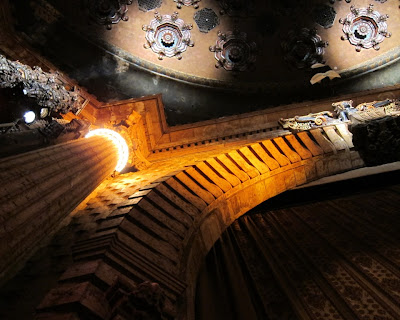 When I recently visited the Million Dollar Theatre, Sid Grauman's pioneering movie palace in downtown Los Angeles, I knew from a previous visit that the lobby and foyer had been remodeled sometime in the 1950s - as many old theatres were, it was updated, "streamlined" or modernized to compete with television.
When I recently visited the Million Dollar Theatre, Sid Grauman's pioneering movie palace in downtown Los Angeles, I knew from a previous visit that the lobby and foyer had been remodeled sometime in the 1950s - as many old theatres were, it was updated, "streamlined" or modernized to compete with television.
What I didn't know was what had been there before - and what's still there behind it all.
Designer William Lee Woollett's decor scheme was not just intended to mimic a classic historical style - it was intended to create an atmosphere that would engage the audience, not just on the superficial level, but also subliminally - even spiritually.
Roberta B. Thudichum, a design critic writing in the journal "The International Studio" in 1919 writes rather breathlessly how Woollett received the commission. Newly relocated to Southern California, he dreamed of
some medium wherein he might portray, in a manner hitherto unaccomplished, a spiritual creation of the varied phases of American life. At the psychological moment a request came for him to draw the plans for the architect of this theatre. He accepted at once, not knowing who might develop his ideas or ruin them, but leaving every other interest in the hope that his dream in the abstract of some thing different from the overworked modes of the day might materialise in the concrete.Of course, according to the article, it did. He and his patron, Sid Gruman, were on the same wavelength. Woollett was allowed to design the interior, all the furnishings and even paint the fantastic murals adorning the theatre walls.
It was an entirely new take on design in the realm of commercial architecture. The reviewer goes a little over the top in describing how singular this was:
It is conceded to be the first to symbolise the new America emerging from its baptism of blood, proud of the past, fearless of the future, joyously singing the song of the New Race, the New Peace—World Democracy.
Out of the arts and architectures of the past, out of the melting pot of the ages the creator has moulded from clay, colour and stone a castle beyond the beauty of dreams, ultra modern yet without the blatant marks of a nouveau genre, mellow in tone and texture and harmonious throughout. Those whose sensibilities are attuned to the conventionalised forms of the old schools naturally revolt at the daring thing which Mr. Woollett has done—marrying the new and old with its violent contrasts of classic Greek and richly ornate Chirreguesque...Mr. Woollett maintains that architecture is a vehicle for the translation of abstract values—that it should not be merely the trekking of historical scenes across one's vision; that details should be used for their psychological significance not for their correctness in any one style.
Woollett chose to expand on themes from literature and history for the murals that lined the lobby, mezzanine and auditorium walls. A scene from "The King of the Golden River," a well-known fable written by 19th century artist and writer John Ruskin greeted you in the foyer, while the witches from Macbeth and images of Adam and Eve and Cupid adorned other walls in the lobby and mezzanine.
In a 1922 article he wrote for the journal "The American Cinematographer" Woollett himself explained how using a childrens fable as a theme helps appeal to the subliminal inner child of audience members. He shared the notion of his patron Grauman and other showmen that audiences were unsophisticated and undiscerning. Woollett asserts that the typical movie-going audience of his time was about at the artistic level of a fourteen-year-old.
We appreciate that ... the great public for whom pictures are made—represents in intelligence, according to the psychologists, the grade of a twelve or fourteen-year-old child. The picture-art, which shall last and be approved as our very own, must evidently be an art which shall appeal to this grade of intelligence; for the industry of moving pictures, to live must live thru the support of its clientele in the commercial senseBut he goes on to say,
There are many wonderful and beautiful things which the child intelligence apprehends and which are often unfathomed by the adult mind and the adult whose intelligence refuses to pass beyond the age of innocence, retains to a great extent the elemental characteristics of childhood in these wonderful and beautiful phases.He felt you could appeal to the inner child and tap into the imagination, without cheapening your art:
Therefore, artist, standardize your appeal so that this fourteen-year-old adult child of the masses may understand you. You do not stultify your art to "come down" to the people. In "coming down" to meet the public you are in reality "coining up" to the greatest thing in the world, the unspoken, unseen, unheard instincts of the race.It's a little condescending, but that was the attitude of the time. And I have to agree with him to some extent - when I enter the magnificent world of an old movie palace, I am as transfixed as a kid at the fantastic, magical environment. It's why I love historic theatres.
Los Angeles Times society columnist Grace Kingsley, writing of opening night says:
The moment you step out of the work-a-day world into the outer foyer the charm of the place is upon you. There, lining either side wall, are two immense mural paintings in pastel shades but of heroic design. Then there's the handsome lobby, from which lead wide stairways to the mezzanine, which is heavily carpeted and which yields visions of tapestries, statuary and mural painting in bold and brilliant design.Kingsley takes us up the curving stairways and through the hallways to see the "long vistas" that will charm us, and points out the murals of the fairy tales that lend a unifying theme to the decor - and whose themes are played out in details carved into the organ screens, gargoyles and niches throughout.
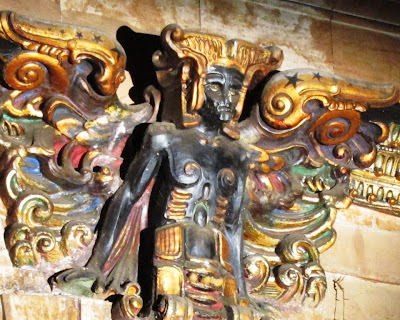
All contemporary accounts mention the figure crowning the proscenium arch - Kingsley calls it a "great winged creature" while Thudichum is more effusive:
The most compelling note of the interior is the weird being surmounting the proscenium arch. This immense winged figure whose eyes have the knowledge of ages represents for the children the Southwest Wind rising from the golden mug when little Gluck's naughty brothers bade him cast it into the fire. But to the serious-minded the sculptor interprets this as Tragedy Triumphant, the symbol of the soul of America tomorrow, rising out of the tests and trials of life, out of the fires of sacrifice on wings star-tipped to rhythms of the infinite. Students of symbology find much more in the five and six-pointed stars, the crown, and other symbols of the organ screens, carvings and sculptures, but the children see only the characters of Ruskin's legend.The huge Doric columns flanking the stage were carried into the stage itself by stage sets or by the use of stage portals. There are no trace of these today - they were probably removed at some time in the past when screens were enlarged. The stage curtains and cyclorama were painted with fantastic and allegorical scenes that at the same time, evoked the wide natural landscape and scenery of California and the west.
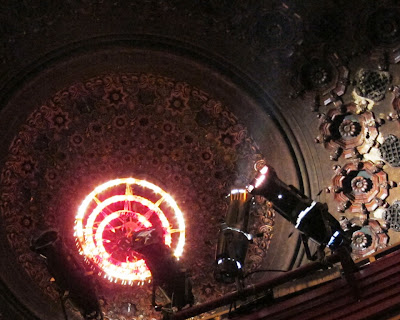
The mezzanine was richly and luxuriously furnished, with tapestries, deep carpets, and colorful murals. The ceiling dome of the auditorium was "hung with gay, glittering forms, starry coffers with hidden lights, flowers, and jewels in gold and platinum, all scintillation sunlight beneath the blue of a happy summer sky."
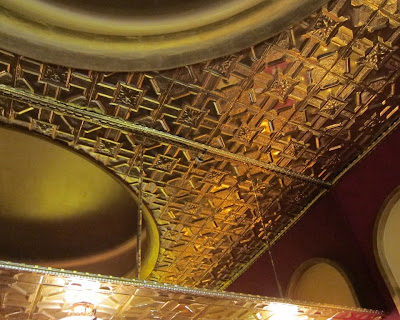
When you're in the theatre today - perhaps for a Los Angeles Conservancy Historic Theatre walking tour - you can get a taste of this splendor, but most of it has disappeared. The mezzanine and the lobby are completely changed, with a goofy-looking dropped ceiling in the lobby, and white paint in the mezzanine.
But the work is still here, hidden away.
The non-profit group Los Angeles Historic Theatre Foundation has produced a video showing Woollett's lobby murals, hidden behind the plasterboard and false ceiling. Executive director Hillsman Wright tells how they can be saved. You can see them if you go HERE.
Woollett worked in a new technique, painting directly on the concrete as it came from the molds. This reminds me of another historic building in downtown Los Angeles, the old City Club, where the dining room was also decorated using this technique.
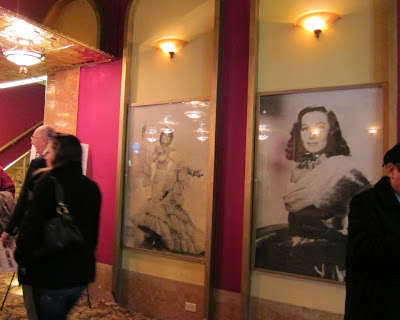 Behind these unassuming panels of plasterboard lie hidden treasures. Perhaps someday they'll be revealed.
Behind these unassuming panels of plasterboard lie hidden treasures. Perhaps someday they'll be revealed.UPDATE - It seems that when I embed a video, if you're using Explorer as your browser, the comment link sometimes doesn't appear. Comments are open for this post, so if you want to comment and can't see the link, try doubleclicking on the title to this post and see if the comment link appears. Thanks!
1 comment:
Wow! I love that all that history is safely ensconced behind the plasterboard...maybe someday it will be restored and protected.
You would be a wonderful guide for tours of historic Los Angeles!
Post a Comment